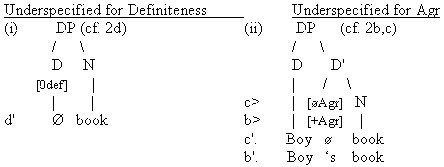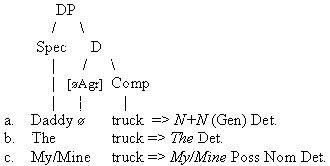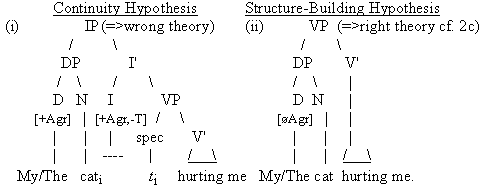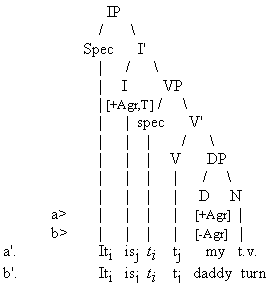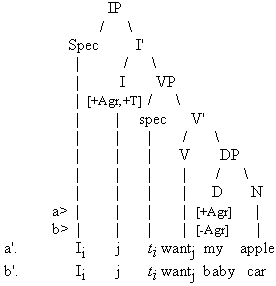
Non-Correlation between D and T Joseph Galasso University of Essex 1997
0. Introduction: A Correlation between D and I (Hoekstra et al.) Hoekstra, Hyams, and Becker (1996b) argue that a correlation exists between the specifications of D and I, and that this correlation functions intra-sententially—i.e., between the specific features within a given clause. Such a correlation makes for strong predictions: (1)
For instance, the above correlation predicts that one should not find examples of a specified IP alongside an underspecified DP (intra-sentential). Subjects of finite clauses should have either overtly marked (i) plural number (e.g. boys read books) or (ii) nominals with D (e.g., The boy reads books). All instances of non-finite constructions should yield either: (iii) null subjects, or (iv) bare nominals without Det/Number. In other words, typical utterances at the VP-stage (e.g., The/my cat kissing me) where an overt case-marked D(P) manifests without the corresponding functional category IP should be banned. The nature of the correlation stems from the notion that once a formal Agreement/Tense feature becomes specified, the specification affects the entire range of relevant features in the clause. Although Hoekstra et al. take the definiteness feature of the Subject as the specific features deficit responsible for the underspecification of DP (number being utilized as the main deficit of D leading to null subject/underspecification of IP), we can naturally expand this notion of Definiteness to the +Agreement feature in Prenominal Possessive D(P)s. This extension is made feasible by Abney’s (1987) seminal work that argues that possessive nominals are in fact DPs Headed by a null determiner that carries the formal-Interpretable/+Agreement property. In following Abney, a specified DP phrase in (2) below could have one of the following two structures (2c,d illustrating the pre-underspecified VP-stage): (2)
(2')
(Conflated trees are to be read as follows: the arrowed letter (c>) indicates the feature setting involved, the corresponding primed-letter (c') indicates the token example.)
We draw out attention here to the utterance Boy book (=Gen) (cf. 2c) (expressed in 2'ii above) regarding the pre-underspecification stage-1 below. In (2c), the Head of DP is vacuously filled. The above token examples taken from my stage-1 (see below) typify this structure. For instance, DP utterance seemingly containing a Specifier and Complement could be void of any (formal) morphological material for feature specification in the D-Head (alternatively, the Head could be filled with the semantically-based +Def feature). Consider the following examples taken from the pre-underspecification VP-stage found in my data (cf. 3 below): (3)
The structure above suggests that the child at the VP-stage matches the adult skeletal structure of DPs but that she fails to realize any of the formal (-Interpretable) feature specifications of the Head (see footnote 1). (This amounts to saying that DPs emerge on the scene at the very earliest stage of language acquisition.) Hence, categorial features along with +Interpretable nominal features are immediately accessible to the child (at LF), such as semantically based phi-features. Case properties (+Agr) on the other hand, clearly being -Interpretable (at LF), are out of bounds for the child at this stage: Case can only emerge once the functional IP-stage has projected carrying along with it the likes of formal/abstract properties. In sum, then, we are basically claiming that DPs emerge as an adult skeletal structure at the VP-stage, but that there are no specific formal properties attached to the Head D that have to do with formal aspects of checking. We can recapitulate this notion by addressing the intrinsic asymmetry found between Subjects and Objects. The notion that only the subject is effected by the correlation (as cited above) enforces this asymmetry found between subjects and objects—namely, the clausal positioning of these two DPs seem to be of some relevance. This prompts us to reconsider the idea that apparent Accusative DPs (in Object position) do not necessarily abide by those same correlate constraints typically assigned to their Subject/Nominative DP counterparts. For instance, Chomsky has suggested that the Case of a given Expletive (There) would depend on its counterpart associate DP within the given clause. For example, the expletive there in the sentences: (4) a. There is a book on the shelf would take on its appropriate Case via its associated DP within that same clause: a'. DP is...(DP=Nominative) This could be expanded to say that a DP in Object position is of a very different category (regarding aspects of features) than say a DP in Subject position, even though the lexical entry is apparently the same: (in this example, being There). I take this difference to be of a lexical vs. formal kind respectively, having nothing to do with the lexical item per se, but rather having everything to do with the item’s feature specification. Specifically speaking, a DP—(i) either at a given VP-stage or (ii) infixed within a VP projection of an otherwise underspecified IP-stage—could theoretically exist without its formal agreement features, and carry only Accusative/Objective Case (via default). Hence, at the VP-stage, a Subject DP could theoretically hold exactly those same feature specifications as its Object DP counterpart (viz., only those +Interpretable phi-features would apply). 1. The Data There exists in my data what seems to be a pre-underspecification stage where only N+N (Genitive) constructions and Agreementless my/mine DPs appear. This stage 1 preexists any form of (under)specification regarding IP Tense and/or Agreement—hence, there is in all actuality no IP projection. The best means of describing this stage is to call on the notion of The Lexical Deficit Analysis (=LDA). The LDA basically states that at an early stage of language development, the child misses out on e.g., Case marking simply due to the fact that the child has yet to acquire the specific lexical entry involved with Case. An altered tactical approach to LDA would be to assume that although the child indeed has the lexical entries for DPs The-Me/My, such entries lack items of case specification and, thus, are to be considered as completely different entries (altogether) as opposed to their case marked counterparts The, My and Mine, all of which mark for [+Agr]. (This amounts to saying that lexical entries are somehow defined by their ‘bundle-of-feature’ (some features being acquired later than others.) The DPs cited below all mark [-Agr] and never fluctuate between [+/-Agr]—hence, there lies the distinction. The range of possible lexical DPs (all taking the default Objective case) presented below are of the following, all showing a consistent [-Agr]: The(def/obj), N+N(=gen)(obj), Me/My/Mine(obj). Evidence in support of this distinction is, I think, strengthened by the fact that Nominative Subjects/Nominative Possessives [+Agr] never appear at this stage. In fact, the two obvious benchmarks for positing IP—viz., (i) Nominative Case and (ii) Finite Verb (Agr/T respectively)—never manifest in stage 1. (5) Table 1 (Files 1-8)
The two predominate schools-of-thought regarding language acquisition would characterize a typical VP structure based on the above token examples accordingly: (6)
In (6i), the DP shows [+Agr] in the absence of any overt specification for INFL—Tense is unspecified and Agreement may or may not be specified depending on the theory you accept here. (Whatever the case, no overt factors present themselves in such a way as to force a [+Agr] specification for (6i), outside of theory internal reasons.) The most parsimonious structure is clearly that of (6ii) where there is no overt need to project Agr since the DP might just as well be considered as Objective carrying the default case. Our claim here is that at stage-1—where there is no evidence at all of a IP projection—overt DPs (in Subject/Object position alike (e.g., My/The (cf. 6ii)) can only take-on the case of Accusative/Objective (possibly via default) without having to enter into any checking relation. In the sense of (6ii), there is no established checking relationship within DP just as there is no checking relation within IP: since T/Agr are simply inert in (6i), they haven’t the need to enter into a checking relation. We take the analogy here that the Determiner The can equate to the pronominal possessive My as a natural extension given the fact that they both seem to encode purely semantic/+Interpretable features at this level. In the sense of (6ii) above, The/My pertain to +Interpretable phi-features having to do only with semantics of e.g., definiteness, etc. and have nothing whatsoever to do with the more formal and abstract [-Interpretable] features such as Case Agreement. The distribution/inter-relation between overt (Pro)nominals can be summarized as follows: (7)
It is clear form this distribution that the early My/Mine examples above can't be considered as having true Genitive case since they are (cf. 7c) considered here as carrying the (default) Objective case. 1.2 DP/VP Default—Evidence from Bilingual Code-Switching Meisel’s (1994a), recent work on bilingual code-switching has yielded some interesting results in this area. For example, Meisel suggests that DPs originating lower down in the tree than IP don’t seem to serve as a natural functional barrier/constraint to intrasentential code-switching in the same way as their counterpart IP/CP functional categories do. Meisel claims that this is due to the fact that there exists a two tier class of functional categories: (i) The IP/CP functional category class which universally can host verbal elements; and (ii) the DP which falls under a rather impoverished functional class since it can’t universally host verbal elements and is rather orientated around nominals (Paradis et al. (1996) have also come to the same conclusion—finding that DPs in their data projected way before any other signs of the functional categories IP/CP). Meisel’s hypothesis predicts that the child, at the given VP-stage, will us both DPs and VPs but that neither of these categories can serve as a syntactic constraint to switching—hence, mixing (of the two languages) occurs freely between D and N within VPs. It is only when the IP-stage, triggered by the finite verb paradigm, has emerged, that a given DP (fixed within the upper IP projection) functions as a syntactic boundary. This amounts to saying that whatever functional +Feature is involved with the constraint of the DP for the IP projection (=DP/IP), it doesn’t initially surface or lower onto the DP in the VP projection (=DP/VP). Hence, this observation paves the way for an important distinction to be made concerning the two types of DP—(i) a (DP)/VP (carrying only the Objective case (or default), and (ii) the (DP)/IP (carrying the more formal Nominative, Genitive cases (as in 7 above)). The following French/German mixed utterances come from Meisel’s data. (Although I won’t delve into the matter here, my personnel data-base on bilingual switching yields plenty of such mixing between D and N, either at the VP-stage or within the VP projection of a IP-stage): (8)
Meisel claims that instances of mixing of the DP/VP kind are predicted to occur, particularly (lower) Object DPs within IP projections. The counterpart mixing of (upper) Subects DPs within IP projects don’t occur (op.cit:433). Thus, the following examples of Subject/DP mixing of the DP/IP kind would violate the syntactic constraint on switching: (9) DP/IP Constraint vs. DP/VP Non-Constraint a. * [IP The garçon is my friend] b. [IP The boy is [my ami]] b * [IP On goes to the school] d. [IP We go to [the école]] 2. Stage-2 It is the second IP-stage of my data where we are able to unravel Hoekstra et al.’s notion of a D to I correlation. In the following sections, we look to instances of IP projections that do and do not bear a correlation between the specifications of D and I.2.1 Poss. Nominals with Copula The first bit of evidence against the correlation comes from Possessives with Copula Verbs. This stage represents the onset of the Functional Categorial stage where IP is seen to project. Table 2 in (10) illustrates our No-Correlation Hypothesis being claimed here:(10) Table 2
(10')
The ratio of incorrect-to-correct possessive cased constructions within an IP copula phrase is approx. 1:5 (respectively) with an overall 17% incorrect usage for required contexts. The percentage may not seem large at first sight, but keep in mine that our only task here is to dismiss the correlation, nothing more. In fact, the 17% usage of incorrect Poss. Noms. within IPs should by no means be cast as insignificant. 2.2. Poss. Nominals with Nominative Subjects The second bit of evidence comes in the form of Nominative Case constructions. (11)
(11')
2.3 Acc. Subjects with correct Poss. Nom. Case Out of the entire corpus, only 7 examples of underspecified Accusative Subjects (for the Underspecified IP-stage) with correct Poss. Nom. Case were reported. Again, I think this demonstrates no such D-I correlation (and possibly brings about a reverse correlation). (12)
Although constructions such as Him/(He) is/kisses [+F] my/Tom’s friend prevail (indicating a legitimate underspecified IP-stage where the 3prs-sg s has a dual status of either marking +Agr or -Agr/+T with the Subj. carrying the default Obj. case) there are no reported instances in my data where we find correctly specified Possessive ‘s constructions with truly non-specified-[øAgr/øT] Accusative Subjects (cf. *12b) (NB. All token examples consist of My: (e.g., Him kiss my friend). It is this observation that brings about possible morphosyntactic differences between those Possessive Nominals which overtly show the genitive determiner ‘s (e.g., Daddy’s/Our’s) and those which do not (e.g., My/Mine). 3. I-to-D Structural Correlation The examples in (12) illustrate both the dismantling of Hoekstra et al.’s D-I Correlation and suggest that some reverse Structural Correlation might hold. Namely, that a correctly specified +Agr feature specification within the lower DP can coexists along side an underspecified -Agr specification of IP (violating the D-I correlation), but that, and here is the reverse Structural Correlation—a +Agr specification of a DP (e.g., Tom’s friend cf.12b) should not be possible within an overall Non/Unspecified IP (=VP-stage) since abstract and formal -Interpretable features have yet to emerge. Thus, My friend is considered as potentially having the +Agr feature owing only to the fact that the overall stage of the clause represents the underspecification/functional IP-stage of acquisition (notwithstanding its feature underspecifications). This reverse correlation basically stipulates that a Structural Correlation governs what types of specifications the lexical entries will contain: (in a sense, the lower DP/VP checks with the higher DP/IP for signs that the Formal Feature (Case) has indeed been acquired). The structural correlation basically states the following:(13) Structural I-to-D Correlation
In sum, (13) basically calls for a strong Structure-Building view of feature (under)specification—i.e., before the feature can ever be claimed to be [-]specified or underspecified, the relevant category representing the underspecification of the feature must first be acquired. In this sense, a seemingly vacuous early emergence of IP, with both its Tense and Agreement features nonspecified, seems to be devise to address theory internal needs for continuity-sake while exasperating the problem by saying nothing about what the child actually is aware of regarding the feature specifications of the lexical entries. In this model, we take it to be the null hypothesis that IPs are not innately present from the very onset of the early multi-word stage (cf. stage-1). Given this assumption, any and all possible formal feature specification processes must await the fully-fledged appropriate functional category—otherwise, the child makes do with only primitive categorial features of the lexical entries: viz., those semantically-based feature/properties that pertain to Det-Noun-Verb. This amounts to a strong version of the Lexical learning Hypothesis ((=LLH) cf. Clahsen: 1990) which states that: (i) the underlying differences found between the child’s and adult’s grammar basically add up to morphological differences between specific (formal) Head-Features of the lexical entries acquired; and (ii) syntactic development is driven by the learning of these new and formal morphological features. Hence (LLH) stipulates a divergence between the acquisitions of Lexical vs. Functional Heads. 4. Summary This paper has briefly examined the possibility of a correlation between D and I and has concluded that such a correlation simply doesn’t hold water. We presented evidence—some taken from syntactic constraints on code-switching—to suggest that the DP can be redefined by its position within a clause: e.g., DPs of a IP projection (or DP/IP) undoubtedly behave differently from its DP/VP counterpart. This amounted to devising a theoretical separation between D of DP and D of IP. Two crucial bits of evidence arguing against the correlation came from my data in the form of (i) Possessive Nominals with Copulas, and (ii) Possessive Nominals with Nom. Case. The data from these two areas showed that while the correlation did maintain the highest percentages in its favor (a natural prediction given what the correlation is based on) the correlation could not defend itself against the onslaught of significant numbers that went the other way. The averages 17%-19% of the counts against its claim were too overwhelming. However, in the process of examining the correlation, a different Structural Correlation of I-to-D was devised in accounting for the Structure-Building nature of underspecification. With this, it was assumed that a pre/nonspecification stage-1 exists where all DPs Subject/Object alike are considered to carry Obj case—a primitive case which via default need not enter into a checking domain at the earliest stage of language syntactic development. Works Cited
Presentation and Outline: 1. The aim of this paper is twofold: (i) Firstly, to present an argument against the claim that a correlation exists between the features specifications of D and I (NB. the bulk of this paper focuses on the Object asymmetry regarding the correlation):
(ii) Secondly, to present some means of accounting for this asymmetry found between Subj. vs. Obj. (DPs) regarding the correlation—culminating in the notion that a pre-underspecified VP stage may exist with DPs (specified for [+Def] only). 2. The unspecified DP construction (cf. 2). 3. The early use of DPs within a VP pre-underspecified stage (cf. Table 1). Let's go with the ‘Right Theory’!!! Such Subject DPs are no specified for Agr and only contain their Objective class properties (possibly [+def/-/øAgr]. We may now extend this type of subject to IP constructions : e.g., The cat hurting me (cf. 6ii) where D and I are both not specified for Agreement. Otherwise, a DP[+Agr] and a INFL [-Agr] would break the correlation. E.g., The other one work. The cat eat cake. The baby eat. The big-one work. My daddy eat my one. etc. 4. Evidence of a two-tier class of DPs—Evidence from Bilingual Code-Switching (cf. §1.1). DP/VP and DP/IP. 5. Stage-2: (a) The underspecified stage focusing on the Object (DP) asymmetry. IP is specified but the lower Object DP may alternate between [+/-Agr] (cf. Table 2) 6. The Structural Correlation I-D (cf. 12 & 13). 7. Summary: There is no correlation between subject DPs and the specification of INFL. The Objective asymmetry can be accounted for by postulating a two-lass distinction of the functional category DP (cf. Meisel). Objects don’t fit into the correlation precisely for these reasons—viz., they have nothing to do with the functional category associated with Agreement. Hence, Subject DPs (=Obj case) project either along side +/-INFL at the underspecification stage. It is at the full-fledged target stage where we see correct feature specifications being consistently manipulated. [i] Radford
(1990:108) (citing Abney: 1987) suggests that the utterance My
tiger book likewise might have the following adult structure:
[DP My/Mine [D e/ *’s][NP tiger book]] where there is an empty allomorph
of the Determiner ‘ (phonetically null) which assigns Gen Case.
In the child's utterance (cf. 2c) the allomorph would be grammatically
null—hence the The-to-My analogy (both possibly indicating
+def only). The overgeneralization would then stem from the empty
allomorph being phonetically realized (as cited above e.g., * ‘s).
Radford adds that such DPs as My/Mine in early child speech are
imposters—i.e., though they look like adult versions of Possessive
Nominals, they in fact function as simple specifiers of D and haven't
the same allomorph of Gen case ( ‘s) as granted in the adult structure |
